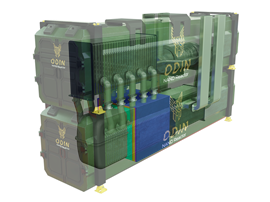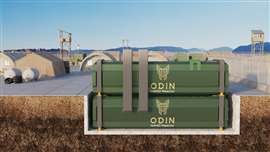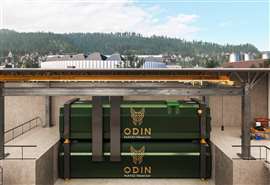Power of the atom: Nano Nuclear Energy
14 November 2024
 Transparency of full Odin microreactor (All photos courtesy of Nano Nuclear Energy)
Transparency of full Odin microreactor (All photos courtesy of Nano Nuclear Energy)
Power generation invariably involves two elements; a fuel product and a system which can convert that fuel to usable energy. A well-maintained liquid- or gas-fuel generator can have a working life of many decades, but these will always need a constant and reliable fuel supply, which can be expensive to set up and maintain in a remote location.
Is there an alternative which could break the need for a constant fuel supply? Solar power offers that potential, but until photovoltaic panels become more efficient it would need an array measured in acres to charge a large battery-electric gen set. Wind is another possibility, but the turbine(s) are unwieldy and the wind itself cannot be guaranteed.
Looking elsewhere, nuclear energy has been delivering power to national grids for decades. It would certainly solve the refuelling problem, but bringing that tech to the microgrid market would seem unfeasible. But commercialisation of microreactors is closer than you might think. Nano Nuclear Energy (referred to as Nano) is a company planning to bring the power of the atom to the gen set market, while also working on nuclear fuel fabrication, fuel transportation solutions and related consulting services.
The company now has two microreactor versions in development; ‘Zeus’ is a solid core battery reactor, while ‘Odin’ is a low-pressure coolant reactor. Each of these is designed to fit within a standard shipping container.
James Walker, CEO of Nano, spoke with Power Progress International about the company and technology. “When we formed the company a few years ago, there were already some outfits developing small modular reactors; the microreactor side of the industry was far less developed.”
 James Walker, Nano Nuclear Energy
James Walker, Nano Nuclear Energy
Continuing, he noted that the microreactors would be ideal for mining, oil and gas drilling and military bases, but also disaster relief – essentially cases where diesel is currently the only alternative but expensive to supply. “Because you’re only competing with the cost of remote diesel, which is very high, to have a power system which doesn’t need to be refuelled for 15 or 20 years. It would make the systems very competitive,” Walker explains.
Nuclear fission 101
Going back to the original thought, it’s obvious that a microreactor would eliminate any need for refuelling. But what is happening to produce the power?
Within the reactor, atoms of uranium 235 are forced together until they reach a critical mass. At this point, neutrons released under pressure start splitting the uranium atoms in what becomes self-sustaining chain reaction. It is this which releases the positive energy effect.
The intensity of the chain reaction is managed using control rods. These are made of materials which absorb neutrons, such as boron, cadmium, silver or indium; these reduce the quantity of free neutrons to slow the reaction process.
“It’s a very basic system,” says Walker. “Inserting the rods can be done remotely, so no one with the technical expertise to manage a reactor needs to be onsite. Regulations also require a minimum of two redundant backup systems, which essentially means there are two independent sets of rods.”
Business model
The microreactors were developed by teams at the University of California in Berkley and at Cambridge University. Each had some key targets, says Walker: “It had to be a transportable system, which could be shipped by road, rail or sea. Also, it had to have the ability to quickly plug into the local grid; it can’t require any related installation works to get up and running.”
A further element of the design was minimal oversight. Walker states that very few personnel are needed where the systems are deployed, possibly limited to security and a mechanic. “You wouldn’t need a nuclear engineer or physicist,” he adds. A remote monitoring system is linked to each installation to check on performance.
 Odin microreactors prepared for truck transport
Odin microreactors prepared for truck transport
When the microreactors are launched, Walker says that he expects rental to be the use model of choice. “There’ll be little or no interest in buying, operating and decommissioning a microreactor. Some very big companies might do that, but most customers will just want to buy the power.
“There are remote communities up in northern Canada that survive using only diesel generators. That’s 800 people who collectively spend about $10 million each year on fuel. Looking at the 15- or 20-year lifetime of a microreactor, that’s $150 or $200 million on diesel. A microreactor can be assembled and delivered for a fraction of that cost. In cases like that, we know the rental model will work.”
He adds that there’ll be a capital loss up front for Nano, but once that investment has been repaid the microreactor will deliver pure profit.
Fuel production
Both microreactor versions use high-assay, low-enriched uranium (HALEU) fuel, which would be produced by Nano and then moved by the Advance Fuel Transportation subsidiary. The company is the exclusive licensee of a patented, high-capacity HALEU fuel transportation ‘basket’ developed across three major US nuclear laboratories.
HALEU Energy Fuel Inc. was formed when it became apparent that existing supply chains in the US would not be able to deliver the necessary fuel. An integrated manufacturing facility is planned in Oak Ridge, Tennessee for enrichment, deconversion and fabrication of the material.
“Looking at the technology as a whole, the public needs to understand that it’s actually quite difficult to make a nuclear reactor of any type go into meltdown” James Walker, Nano Nuclear Energy
Nano is partnered with LIS Technologies, which will deliver the enrichment portion of the fuel processing. This uses a laser-based system to separate individual isotopes of uranium from those which are unwanted and concentrate the collected material.
Walker says that the fuel used in a microreactor is the same uranium 235 (the fissile isotope which makes up less than 1% of all uranium) as found in a full-size reactor. The key difference is that in a smaller reactor it is better to have a higher level of enrichment.
This means that where a large pressure water reactor (PWR) in a gigawatt-size plant would use uranium dioxide enriched to less than 5%, the HALEU fuel is capped at about 20% enrichment. At the other end of the scale, weapons-grade uranium is more than 90% pure.
“How you transport that fuel would be adapted slightly, but the crucial point is that it’s not any more unsafe,” explains Walker. “We have to be very clear on this, a reactor can’t blow up.”
In the box
As noted earler, the microreactors being developed by Nano are intended to fit within a standard shipping container. Asked whether the container would include miniaturized versions of all the equipment featured on a standard reactor, Walker says the hardware is much less complicated.
“Conventional reactors all use water, it’s a great coolant. But the boiling temperature of water is comparatively low and the heat produced by the uranium is so high that they need pressurizers built into the system to prevent boiling over,” he says.
 Artist’s impression of an Odin microreactor located on a military base
Artist’s impression of an Odin microreactor located on a military base
In a full-size reactor, failure of the pressurizer would cause the core to melt. In a microreactor, even if every coolant system were to fail, the unit would passively radiate the heat without causing any core melt. The worse scenario is that the microreactor would stop delivering usable energy to the microgrid.
Walker: “If a microreactor was installed at a military base and it was hit with a missile, the explosion would actually make [the material] less radioactive. That’s because if the material you’re relying on to create the critical mass and chain reaction is no longer being forced together, the uranium would naturally start to cool down and become less radioactive.”
Regulation roadblocks
The US has the longest-running nuclear program in the world. Walker states that over the decades the industry has developed a deep level of bureaucracy which has made nuclear energy produced in the country more expensive than anywhere else in the world.
Bureaucracy has also extended the time it takes to complete the licensing process needed to take a reactor from prototype through to commercial production. To further complicate matters, the cost of the process is dictated by the regulator and can become prohibitively expensive.
Walker: “Nuclear power should, theoretically, be the cheapest form of energy in the world due to the energy density. But because of licensing, the time it takes, the capital costs are very high and so financing is very expensive. Looking at a standard reactor, 70% of the budget can be attributed to financing costs.”
Walker notes that if Nano receives just one license, that would be sufficient to cover production of the modular microreactors. And as economies of scale take effect, capitalisation costs will be “dramatically reduced” by unit, making the systems more affordable on the open market.
On top of that, in September 2024 the US government passed the Advance Act, which is intended to cut licensing costs for advanced nuclear reactor technologies and simplify permissions, reduce fees and cut delays.
“This reform should help to streamline licensing,” says Walker. “To take a standard licensing framework and apply it to a microreactor is not just overkill, a lot of the targets are just not applicable. So we’re hopeful that this will result in a demonstrably different framework for different reactor types.”
As it stands, Nano is in the pre-licensing application phase of the process, which includes the type of reactor, the power output and anticipated launch dates. Walker says that when approval is received the company will start building a full working prototype of the microreactor at the same time as submitting the formal licensing application; the Advance Act has outlined a maximum of 25 months for this process, which is when Walker is anticipating receiving final approval.
Decommissioning microreactors
Upon receipt of that approval the microreactors will be launched in the US, but Walker believes larger markets will be in countries and regions which have heavy industrial operations or populations in remote areas with little or no power infrastructure.
“We’ve been speaking to governments in Indonesia, Thailand and the Philippines. They have millions of people dotted over hundreds of islands and they all subsist on diesel generators. This is logistically difficult, very expensive and very bad for the environment. They’re very keen on the microreactors, there could be hundreds of systems deployed across these communities.”
All good things come to an end and the microreactors will eventually have to be decommissioned. Walker says that the original idea was to defuel at site and leave the reactor for six months, after which it would be ready for scrap as a non-nuclear device.
“There’ll be little or no interest in buying, operating and decommissioning a microreactor. Some very big companies might do that, but most customers will just want to buy the power” James Walker, Nano Nuclear Energy
But the start of the so-called Project Pele by BWX Technologies has changed those plans. As part of this, an application has been made to allow both fuelled and spent reactors to be moved by road, which would give permission for the units to be decommissioned at a dedicated location.
“We have developed technologies to move both new and used fuel, but it would be much easier to insert control rods and move the reactor to where we can manage the defueling process,” says Walker.
That also opens the door for a fully-mobile microreactor – Nano has set up Advanced Fuel Transportation Inc. for this purpose. In practise, a microreactor could be deployed for five years, have the control rods inserted before it is moved to another site. Walker: “In the case of mining, the end point where power is needed could be miles from the original location. Moving the microreactor would be easier than installing transmission cables,”
Market acceptance
It’s clear that events such as Three Mile Island (Harrisburg, Pennsylvania) and Chernobyl (Pripyat, Ukraine), have left an indelible mark on the global perception of nuclear power. Following the partial meltdown of reactors at the nuclear power plant in Fukushima, Japan, the German government stated it would decommission all existing nuclear plants; the last sites were taken offline in 2023.
 Odin microreactor in long-term site
Odin microreactor in long-term site
Walker states that a large part of the issue is the gap between reality and public perception. At Fukushima, which used older technology, it still took the combined forces of an earthquake and tsunami to compromise the plant. Even then, the worst of the disaster was contained using sea water. After use the water was less radioactive than the sea into which it was flushed.
“Even looking at Three Mile Island, the worst accident in the US, no one was killed and the second reactor at the plant is still operating to this day,” he points out. “At Chernobyl, the people who left the area after the disaster have a lower life expectancy than those who stayed.
“Looking at the technology as a whole, the public needs to understand that it’s actually quite difficult to make a nuclear reactor of any type go into meltdown.”
A full version of this article will be published in the Q1 2025 issue of Power Progress International magazine
POWER SOURCING GUIDE
The trusted reference and buyer’s guide for 83 years
The original “desktop search engine,” guiding nearly 10,000 users in more than 90 countries it is the primary reference for specifications and details on all the components that go into engine systems.
Visit Now
STAY CONNECTED




Receive the information you need when you need it through our world-leading magazines, newsletters and daily briefings.
CONNECT WITH THE TEAM










